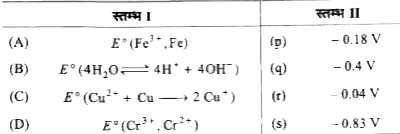Given that, Co3++e−→Co2+E∘=+1.82V
2H2O→O2+4H++4e−,E∘=−1.23V.
Explain why Co3+ is not stable in aqueous solutions. Solution in Gujrati
The Ecell can be calculated as follows:
4×[Co3++e−→Co2+],E∘=+1.82V
1×[2H2O→O2+4H++4e−],E∘=−1.23V.
Add: 4Co3++2H2O→4Co2++4H++O2,E∘=1.82−1.23=+0.59V.
Since, Ecell is positive the cell reaction is spontaneous. This means that Co3+ ions will take part in the reaction. Therefore, Co3+ is not stable.
Similar Questions
Given electrode potentials: Fe3++e−→Fe2+:Eo=0.771VandI22e−→2I−,Eo=0.556 V then Eo for the cell reaction 2Fe3+2I−→2Fe2++l2 will be:
View SolutionFor the reactions {:(MnO_(4)^(-)+8H^(+)+5e^(-)rarr Mn^(2+)4H_(2)O","E^(o) = + 1.51 V),(MnO_(2)+4H^(+)+ 2e^(-) rarr Mn^(2+)+2H_(2)O"," E^(o)= + 1.23 V ):} then for the reaction : MnO_(4)^(-) + 4H^(+) + 3e^(-) rarr MnO_(2)+2H_(2)O","E^(o)
View Solutionमानक अपचायक विभव 25∘C पर निम्नलिखित हैं
E∘(Fe3+.Fe2+)=+0.77VE∘(Fe2+/Fe)=−0.44VE∘(Cu2+/Cu)=+0.34VE∘(Cu+/Cu)=+0.52V
(E∘(O2(g)+4H++4e−→2H2O)=+1.23V,),(E∘(O2(g)+2H2O+4e−→4OH)=+0.40V),(E∘(Cr3+/Cr)=−0.74V, E∘(Cr2+/Cr)=−0.71V)
स्तम्भ I में दिए गए रेडॉक्स युग्मों को स्तम्भ II में दिए गए अपचायक विभव से सुमेलित कीजिए तथा स्तम्भ के नीचे दिए गए कोड का प्रयोग करके सही उत्तर चुनिए |

View Solutionएक जलीय विलयन में NO−3 आयन के अपचयन के लिए E∘ का मान + 0.96 V है | कुछ धातुओं के आयनों के E∘ नीचे दिए गए हैं
V2+(aq)+2e−→VE∘=−1.19VFe3+(aq)+3e−→FeE∘=−0.04VAu3+(aq)+3e−→AuE∘=+1.40VHg2+(aq)+2e−→HgE∘=+0.86V
जलीय विलयन में NO−3 द्वारा ऑक्सीकृत होने वाला/वाले धातु युग्म है (हैं)
View SolutionCalculate DeltaG^(@) for the given reaction occuring in fuel cell (i) O_(z) + 4H^(+) + 4e^(-) rarr 2H_(2)O E^(@) = 1.229 volt (ii) 2H_(2) rarr 4H^(+) + 4e^(-) " " E^(@) = 0 volt
View SolutionCalculate ΔG∘ for the given reaction occuring fuel cell
(i) O2+4H++4e−→2H2O,E∘=1.229 volt
(ii) 2H2→4H++4e−,E∘=0 volt
View SolutionGiven 2H2O→O2+4H++4e− , E0=−1.23V. Calculate electrode potential at pH = 5.
View SolutionTwo electrochemical cells are assembled in which the following reactions occur :
V2=VO2++2H⊕→2V3++H2O
V3++Ag⊕+H2O→VO2++2H⊕+Ag(s)
Calculate Ec− for half reaction V3++e−→V2+
Given :Ec−.(Ag⊕∣Ag)=0.799
Ec−=Ec−.V4+∣V3+−Ec−.V3+∣V2+=0.616V
Ec−=Ec−.Ag⊕∣Ag−Ec−.V4+∣V3+=0.439V
View Solution
